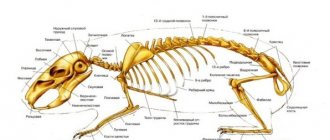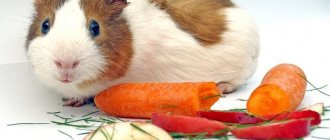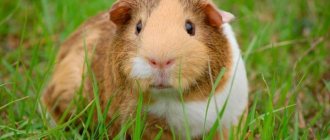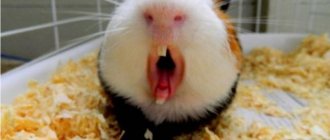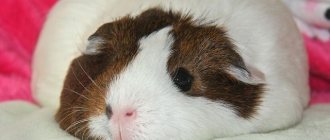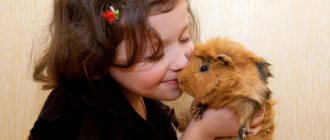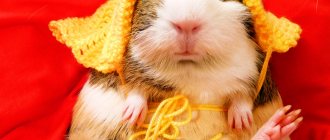- home
- Guinea pig
- Guinea pig health
02/07/2019 Guinea pigs have strong immunity. But due to poor diet or infection, they experience constipation. If left untreated, prolonged stagnation in the intestines along with bloating leads to death. If the pet develops appropriate symptoms, the owner must take the necessary measures in a timely manner.
Why does a guinea pig get constipated?
The main reason why guinea pigs become constipated is nutrition. The following dietary deficiencies lead to the disease:
- Lack or abundance of food;
- the share of hard and dry food prevails over the share of soft and juicy;
- lack of nutrients;
- long periods of time between meals;
- insufficient drinking water;
- feeding inappropriate food (from a common table, sweets, baked goods, etc.).
In addition, lack of activity in your pet can lead to constipation. He should be allowed to run outside the cage more often. This will prevent not only constipation, but also obesity.
At the first signs of constipation, it is necessary to adjust the animal’s diet. If this does not lead to positive results, the cause of the disease is most likely internal pathologies. The most common of them:
- Weakening of the muscles in the intestines;
- gastrointestinal oncology;
- inflection of the gallbladder.
enteritis and enterocolitis;
Internal pathologies cannot be dealt with at home. If, after adjusting the diet, constipation does not stop within 24 hours, the pig should be taken to the veterinarian.
Symptoms
Not every guinea pig owner can immediately determine that his pet has problems with stool.
Often, feces in the form of small soft pellets are perceived as an alarming signal. They begin to stuff the pet with medications, and as a result, it develops a problem of a different nature - constipation. Soft stools are just a consequence of the presence of succulent food in the diet. The main signs that should cause concern to the animal owner are:
- bloating and gas;
- frequent foamy bowel movements;
- stuck together hairs with fragments of feces around the anus;
- unpleasant odor;
- refusal to eat;
- elevated temperature;
- rumbling in the stomach.
The most significant symptoms of diarrhea are loose stools and discolored stool. They can be of a different nature and indicate the presence of a particular disease.
Diarrhea can be completely liquid, foamy, and mucus is often present in the stool. These are serious symptoms. An even more dangerous sign is the presence of blood in the stool. If they are detected, you should immediately contact a veterinarian. Such diarrhea in animals may indicate intestinal diseases and internal bleeding. Among the most dangerous diarrhea is the one that is caused by various pathogenic bacteria - for example, salmonella, which is also dangerous for humans. And an animal infected with pseudotuberculosis or plague often dies within a day.
How does constipation manifest in guinea pigs?
The first symptoms of constipation in pigs:
- Bloating;
- little or no excrement;
- excessively thick or dry consistency of stool;
- belly hard to the touch;
- lack of appetite;
- the anus protrudes until the rectum prolapses.
The guinea pig does not poop, but constantly stands in a characteristic pose. The animal needs treatment if symptoms do not go away within 24 hours. Over time, the animal begins to experience pain and reacts negatively to touching its stomach. In advanced cases, the mumps becomes lethargic and vomiting begins.
Features of sexual differences and a little about reproduction
When a new tenant appears in the house, of course it is interesting to find out who he is - a boy or a girl? This question should be of particular interest if you have several pigs. When examining the genitals of these babies, it can be difficult to understand their gender, since their organs are very similar to the eye. In males, the anal sac is more prominent. In females you can feel a fold at the bottom of the abdomen, in males there is a thin long vein. It is easier to determine gender by stool. In females the discharge is small and elongated, in males it looks like a rocker arm.
Pigs are born with open eyes and fur.
If you put pets of different sexes in the same cage, sooner or later expect a replenishment. Piglets are born with open eyes and fur, being completely independent. One mother can have up to six of them in her litter. If the plans did not include breeding animals, it is better to purchase one individual or two same-sex ones. Despite its nuances, caring for guinea pigs is not a complicated science. They can become good friends and brighten up your home time.
Treatment of constipation in guinea pigs
Treatment occurs with Vaseline oil. It coats the intestinal walls, facilitating the passage of feces. Dosage – 2 ml per 1 kg of weight. Pour into the mouth using a syringe without a needle every 4 hours until improvement occurs. In addition to Vaseline, olive or rapeseed oil is suitable, but not castor oil. After taking the oil, you need to lightly stroke your pet's belly towards the tail.
If constipation is accompanied by an accumulation of gases, the pig is given Espumisan, Simplex or other simethicone-based drugs. Dosage – 0.3 ml 3-5 times a day. The medicine Metacam helps reduce pain (1-2 drops twice a day).
Additionally, probiotics are used to restore intestinal microflora. Only veterinary drugs (for example, Prokolin) should be used, and not those intended for humans.
Examination of the animal
By taking a closer look at the animal, even without special education, you can identify symptoms of illness.
When examining the cage where the piglet is kept and the absence of fecal matter, it is necessary to remember whether there was any yesterday. Pigs are not coprophagous (eating their own feces), but when mineral balance is disturbed, sometimes such phenomena become the norm. And at the same time the animal will be playful and cheerful.
Examination of the animal and the conditions in which it is kept helps to identify the cause of constipation.
If your pig is truly constipated and you do not detect any fecal matter, then pay attention to:
- general condition (lethargy, depression, moaning, squeaking, grinding teeth);
- refusal of food (feeder with leftover food, the animal does not approach the feeder or has a perverted appetite);
- posture (hunched over, tucked or drooping tail, sitting dog pose, lying with tucked limbs);
- condition of the skin (dryness, dullness, roughness);
- condition of the abdominal part of the body (bloating, hardening, tympanic sound when tapping, pain when pressing on the walls).
Any of the signs should alert you and be a reason to contact a veterinarian.
Sometimes constipation alternates with diarrhea, or once constipation occurs, it turns into normal bowel movements, and after a while constipation occurs again.
Constipation often occurs at elevated temperatures. Water is absorbed very quickly from the intestines, and peristalsis cannot cope with fecal masses and evacuate them.
Bloating in Guinea Pig
Bloating in the abdomen (tympany) and intestines (flatulence) occurs as a result of a poor diet or an infectious disease. Frequent causes of diseases are: fresh wet grass, rotten or herbicide-treated hay, large quantities of fresh cabbage and root vegetables, musty water, sudden changes in feed.
Poor quality food triggers the fermentation process in the stomach. Accumulated gases swell the walls of the intestines and stomach. This is accompanied by difficulty breathing, pain in the abdomen, and atony (weakening of the muscles) of the intestines. If left untreated, organs can rupture from strong gas pressure.
Bloating is noticeable visually: the stomach increases in size by one and a half times. In addition, the animal exhibits the following symptoms:
- Lack of appetite;
- inactivity: the pet sits in one place for a long time without moving, ruffled;
- abdominal pain;
- labored breathing.
Diseases caused by external factors
You can't escape bacteria. An animal, being surrounded by people or other pets, can become infected by airborne droplets, through poor-quality food or water, and infectious diseases. In such cases, the animal's health deteriorates and the animal refuses to eat. Elevated body temperature can lead to seizures. If we go into detail, the causes of diseases in guinea pigs are the same as in humans. Only the symptoms, treatment methods and diagnosis are different. Why is this happening? Because the pig lives with people and there are no serious deviations in the habitat of humans and the pig.
The only thing that can be recognized immediately is diseases caused by parasites. These include fleas, lice and ticks. Owners of long hair - guinea pigs, under the influence of parasites, lose part of their beautiful fur. With such diseases, abscesses may appear. To prevent this from happening, the owner must not only periodically comb the pig’s fur, but also clean the eyes, ears and claws. Fortunately, pet stores sell everything you need to care for pigs.
Diseases caused by parasites in the internal organs of an animal are almost incurable. Why? Because such a disease is recognized already too late. Flukes and tapeworms can live in the animal's intestines. And even if the pig could speak, it would hardly complain of being unwell. Such parasites are very insidious and act slowly. When a person eats low-quality food, loose stools or constipation, loss of appetite and apathy are common. Also acceptable for pigs. You cannot feed them food for other pets. Loving owners pamper their pig with “gourmet” food from the pet store, but problems still arise when the guinea pig does not eat or drink.
If the animal does not eat or drink, you should take your pet to the veterinarian
If suddenly the heating in the apartment is turned off in winter, and the animal’s comfort is forgotten, hypothermia occurs. It can lead to pneumonia and runny nose. These diseases are very dangerous for the animal, because its small body may not be able to withstand the fight against them. If the animal has an elevated body temperature or apathy, then be sure to take the pig to the doctor.
It is very important to devote time to the animal and not let it get bored for a long time. The psychological state of the pig also largely determines the strength of the immune system.
In addition, a joyful animal has a strong immune system and is less susceptible to apathy.
It is important to note that guinea pigs, like any other pets living in captivity, need a lot of vitamins. Without them, any living organism will not withstand the onslaught of harmful factors, and guinea pigs are no exception.
Variety is very important for a pig. Moreover, the animal cannot find food on its own. And the person has no idea what the pet actually needs.
When forming a pet’s diet, we must remember that it needs such “removable substances” as vitamins C, D, A, E. It is especially necessary to provide the animal with vitamin C, it will eliminate diseases such as scurvy. The animal's risk of contracting colds increases
Room lighting is very important for the animal, especially the presence of sunlight. Vitamin D contributes to the good condition of the animal's limbs
With its abundance, the risk of rickets in the animal is reduced. Vitamins A and E are the key to the beauty of a fluffy ball. Thanks to them, the animal’s fur remains beautiful and smooth. In addition, without these substances, the animal’s skin begins to peel off. Vitamin A is beneficial for the animal's visual organs.
Having a guinea pig at home is always a cause for joy. The children are delighted, mom can relax, dad calmly reads the newspaper in the evenings. But if the pig starts to get sick, it’s a disaster. There is no peace for anyone. The pet is sick! Such cases occur extremely rarely; usually, pigs are unpretentious and have strong immunity. But in cases of illness, be sure to take the pig to the veterinarian. The difficulty in defining a disease is that its signs are difficult to diagnose based on the animal’s behavior. Remember that a very dangerous condition is when a guinea pig does not eat or go to the toilet; you must contact a medical facility for a detailed diagnosis.
What to do if your guinea pig has bloating
If constipation in a guinea pig is accompanied by bloating, simethicone-based drugs are used as treatment: Simplex, Bobotik, Espumisan. Dose – 2.3 ml 3 times a day. The medicine helps relieve the intestines of accumulated gases. After taking the medicine, you should gently massage your pet's belly. It is important not to allow the animal to sit still. Active body movements stimulate intestinal motility and accelerate the elimination of gases.
Subcutaneous injections of Metacam or Buscopan (0.2 ml) are used for pain relief. The intestinal microflora is restored by probiotics (Vetom, Linex).
During the period of treatment and recovery, green and succulent food is contraindicated for pigs. The diet includes hay and water. If the pet refuses to drink, the liquid is administered independently using a syringe 7 times a day. Vegetables are offered in limited quantities.
Steps
Part 1
Set up a litter box
Observe your guinea pig and find out where it goes to the toilet most often.
The first step in toilet training a guinea pig is to observe your pet. In most cases, guinea pigs have a preferred location for the toilet. If you place the litter box in this exact location, you will increase the likelihood that your guinea pig will begin to use it for its intended purpose.
Monitor your guinea pig for a few days
Pay attention to where exactly your pet prefers to go to the toilet. The answer to this question can also be found out while cleaning the cage. Pay attention to where in the cage the most excrement and urine have accumulated.
- Place a litter box in the cage.
You can buy a toilet tray for a guinea pig, or you can make it yourself. Just make sure that it is comfortable for your pet to get in and out of it. Place the tray in the corner that your guinea pig most often uses as a toilet. - Make sure the litter box is large enough to accommodate your entire pet.
Make sure the sides of the tray are not very high. The guinea pig should have no difficulty getting over these walls.
If necessary, place several litter boxes in the cage.
Some guinea pigs like to go to the toilet in several corners of the cage at once. If you are faced with this exact situation, most likely your pet will not be able to use the only litter tray. When a guinea pig goes to the toilet not in one corner, but in several, it is necessary to place a litter tray in each such place.
Part 2
Encourage litter box use
See if your guinea pig will come to the litter box on its own accord.
For the most part, litter box training your guinea pig does not require any intervention. Some guinea pigs will start using the litter box right away and some will not. At the very beginning, you need to make sure that the guinea pig does not begin to climb into the tray on its own.
Many guinea pigs quickly understand the purpose of the litter box. If you are lucky, your pet will immediately begin to use it for its intended purpose.
Try stimulating your guinea pig to use the litter box with hay.
If your pet doesn't quite understand the purpose of the litter box, try putting some hay in the litter box. A guinea pig may climb into the tray when it sees hay in it. In addition, if the litter box smells of urine and feces, the pet will quickly realize that this is where it is necessary to go to the toilet.
Change the litter in the tray regularly.
Once your guinea pig starts using the litter box, change the litter regularly. Try to update it every three days. Know that your guinea pig will not go to the toilet in a dirty litter box.
Clean the litter box only every two weeks. In order for your guinea pig to continue using the litter box, there needs to be some odor left on it.
Constipation in a guinea pig occurs infrequently, since this animal has excellent immunity and, in principle, rarely gets sick. Problems with intestinal function in pigs usually occur due to improper feeding.
The main cause of intestinal dysfunction in guinea pigs, which is manifested by poor fecal output or its complete absence, is an incorrect diet, namely:
- excess solid dry food;
- constant overfeeding;
- long interval between feedings;
- lack of minerals;
- feeding your pet food intended for humans.
A lack of fluid in the body can also trigger stool retention, so it is important to ensure that your pet always has drinking water in his bowl. In addition, a common cause of constipation is inactivity of the animal.
This is usually observed in older pigs or when the pet is overweight.
If we talk about more serious causes of constipation in guinea pigs, these include:
- weakening of the intestinal muscles;
- diseases of the gastrointestinal tract;
- inflection of the gallbladder;
- gastrointestinal oncology;
- cysts, adhesions and other formations in the intestines.
If constipation in an animal caused by improper feeding can be eliminated independently, then the above factors require medical treatment.
